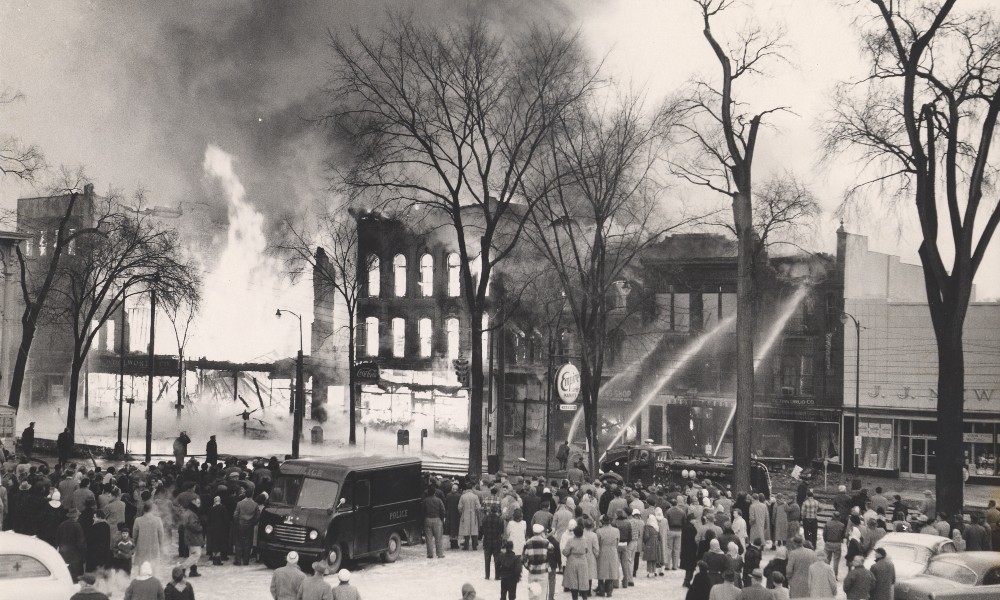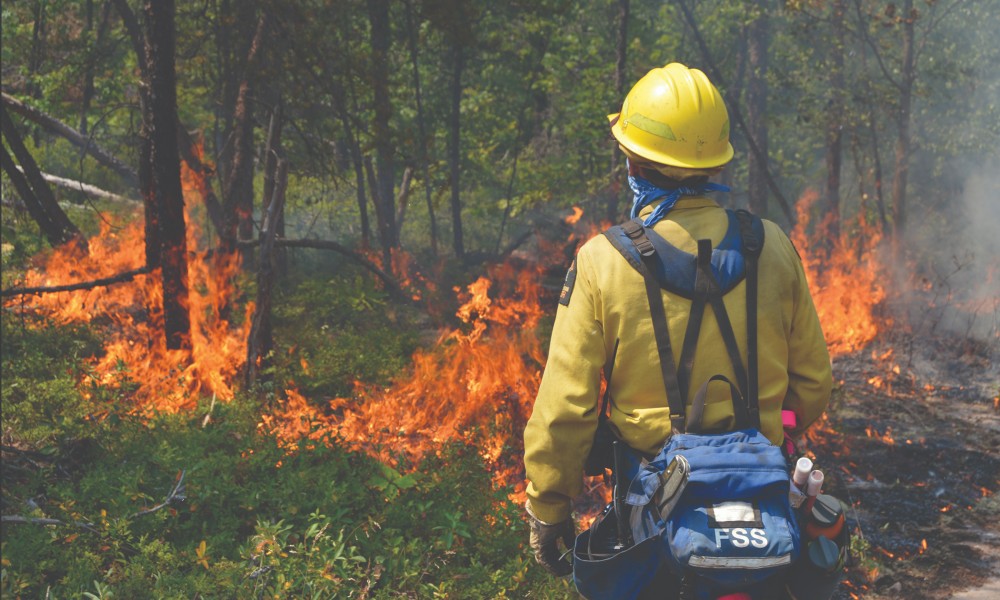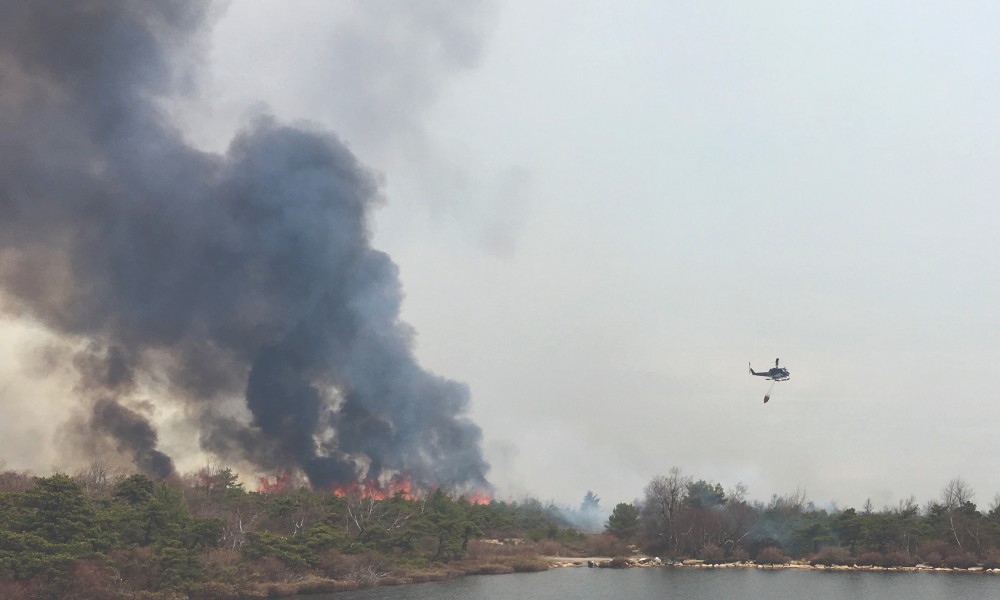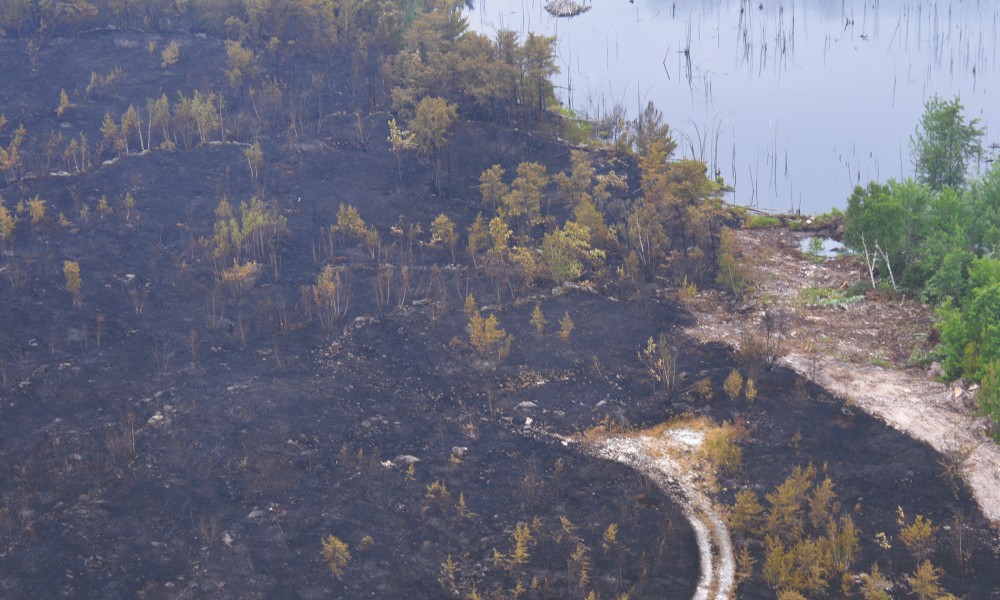When I was in kindergarten, I won a fire safety poster contest, beating out all the other kindergarteners, first graders and second graders at Charlton Heights Elementary. Impressive, I know. My hand-drawn-with-colored-pencils poster (crayons were sooo preschool) featured a picture of a girl hiding in a pile of clothes in her closet on one side and a picture of the same girl standing in her backyard with her family on the other. The message written at the top was “Don’t Hide, Go Outside,” which, I confess, was my mom’s idea.
After my big win, which came with a snazzy $50 bond (not that I knew what a bond was), I expected fire safety to play an important if not prominent role in the rest of my life. After all, I’d spent the first few years of my life visiting the local fire station, checking the fire danger sign held by Smokey Bear at Glen Island on camping trips to Lake George and mastering the art of the “stop, drop and roll.” But, as I got older, I realized fires were less common than the kindergarten curriculum had led me believe. Nonetheless, at least I was prepared.
Since 1980, the number of reported home fires and home fire deaths in the US has been cut in half, as a result of improvements in the construction of fire-resistant buildings and in fire-suppression techniques. In the decades beforehand, too, the incidence of structure fires had been in decline, not only because of improvements to buildings, but also improved methods of home heating. “You did have more fires then because of how people lived back then,” Saratoga Springs Fire Chief Joseph Dolan tells me when I ask about the seemingly unusually high incidence of structure fires in Saratoga Springs in the 19th century. “They didn’t have forced hot air furnaces. They didn’t have gas fireplaces. You talk about the history of Saratoga—there used to be underground connections to all the buildings, because they used to have a person who ran coal from building to building to feed all the coal boilers. When they heated some of those buildings, there were fireplaces. When a hot ember came out on the carpet, the carpet caught on fire. There are a lot of different things that we don’t even think about now that people did back then that were totally normal.”

It’s hard to say if the number of devastating blazes that tore through Saratoga was normal for a city of Saratoga’s size. There certainly were a lot of them, though. Take the years 1865 and 1866: In those two years, three of Saratoga’s biggest hotels suffered major damage due to fire. In 1865, The United States Hotel was destroyed, eliminating one quarter of Saratoga’s hotel capacity, and in 1866, both the Congress Hall Hotel and the Columbian Hotel met the same fiery fate. (The Columbian Hotel caught fire again a century later in 1965, and the flames spread across Broadway, engulfing the Convention Hall as well.) Then there was a series of fires at the Arcade building on Broadway (now home to Spa Fine Art Gallery, Lola Boutique and the Saratoga Day Spa, among other businesses) in 1853, 1869, 1902 and 1966. Damage caused by the 1902 fire, often called “Saratoga’s Great Fire,” was estimated at $200,000 ($4.1 million in today’s dollars) and five people died. Additionally, the Congress Bottling House caught fire in 1826, the Pavilion Hotel in 1843, Saratoga Lake House in 1846, the Saint George Hotel in 1859, the Grand Central Hotel in 1874, Yaddo’s Trask Mansion in 1891, Palace Recreation Hall in 1957, Saratoga Hospital in 1965, Colonial Tavern in 1966 and a Skidmore College dormitory in 1976. In 1955, a fire at 35-37 Caroline Street killed a family of seven and a guest, and when the Saratoga Springs Fire Station property on Lake Avenue was home to a high school, that burned down, too. “There was a time, and this is long before either of us, but in the 1860s and 1870s, that people who came here thought that Saratoga was burning down,” says Ellen deLalla, a former Saratoga Room librarian who helped build the library’s fires database. A 1988 Saratogian article, paraphrasing former Fire Chief Vincent Camarra, might’ve put it best: “Though other cities of comparable size had as many fires, none played host to American and even European society figures the way Saratoga Springs did. A big fire in this town made headlines everywhere.” And close to home, massive fires were an even bigger deal. “Saratogians have a great love for Saratoga,” deLalla says. “So, anything bad that happens is immediately chaos. It hurts.”
In recent years, fires are still a major cause of property damage in Saratoga, though not at the level they were in the 19th and 20th centuries. On Thanksgiving morning of 2016, a fire originating at the restaurant Mio Posto damaged several buildings on the corner of Putnam and Caroline Streets; in April 2018, a structure fire leveled Lake Local on Saratoga Lake; and in August 2018, City Hall caught fire, though much of the damage to the building was, ironically, caused was by the water that poured into it after the drainage pipe in the roof that was struck by lightning melted. These modern-day fires were better contained than they would’ve been had they happened in, say, 1871, when not only were the tools firefighters had at their disposal primitive, but also the fire department was entirely staffed by volunteers. In 1871, three fires broke out in one day causing $100,000 in damage, while all the firemen were out of town at a picnic. As a result, Saratoga organized its first paid permanent fire department in 1883. And for good reason. “The difference between then and now is pretty simple,” then-Fire Chief Robert Cogan told the Saratogian in 2002. “There were many abandoned shut-down hotels. They were targets. You don’t get that nowadays. Most of the real estate has become very desirable. Being occupied makes a big difference.” New firefighting technology, such as thermal imagery cameras and a records management system that identifies where fire hydrants are on an iPad before crews arrive at the scene of a fire, also makes a big difference, as does updating older buildings in the city to meet fire code. “I think the fact that these old buildings are still standing is a testament to the fire service here,” says Chief Dolan, who’s held the position since January 2019.

Despite all the progress that’s been made, more still needs to be done. According to Chief Dolan, the greatest fire-related threat to Saratogians is home heating. “People don’t check their furnaces, and start them,” he says. “We have problems with people who don’t check their chimneys. We do a lot of education to prevent that.” The city is also working to secure an agreement for a third FIRE/EMS station near the Oklahoma Training Track. (Station 1 is currently located on Lake Ave and 2 is on West Ave.) “The discussion about the need for a third fire station has been going on since I was hired—so, go back 20 years,” Chief Dolan says. “Over time, as people move out to the Eastern Plateau [the area near Saratoga Lake], the need for calls has increased out there. The response time—having a third station—will definitely improve, and that’s our mission.”
Most of the fires you hear about in this neck of the woods (i.e. Upstate New York and the Northeast as a whole) are, indeed structure fires. A fire starts in the oven, for example, and the local fire department is called to come put it out. When fires happen in the woods—Chief Dolan calls them “brush fires”—it’s still the local fire department that responds, but when those fires get out of hand, forest rangers from the New York Department Of Environmental Conservation (DEC) are brought in. In that case, they’d be classified as wildfires or forest fires.
Throughout New York State, and in the Upper Hudson Champlain region, where Saratoga is, the main cause of wildfires between 2003 and 2017 was debris burning. That’s why the state institutes a burn ban every spring, when backyard fires are more likely to get out of control. In the Adirondack region last year, the main cause of wildfires was out-of-control campfires, and in Long Island, it was actually arson, which accounted for 77 percent of the 191 wildfires that happened on the island during that time period. Since 2008, the largest wildfire on record in the state of New York was the Roosa Gap Fire, which burned 2759 acres in Ulster County in 2015. And the largest in the Adirondacks was 2018’s Flat Rock Fire, which burned 547 acres in Northern Clinton County.

But the wildfires that you’ve been hearing about in California are a completely different beast. The Kincade Fire that tore through Sonoma County, CA last fall burned a staggering 77,758 acres. The Camp Fire, which killed 85 people in Paradise, CA in 2018, burned 150,000 acres. And the Mendocino Complex Fire, also in 2018, burned 459,123 acres across four counties in the Golden State. “What you get very infrequently here in New York State are crown fires [forest fires that spread from treetop to treetop] that run quickly and are almost impossible to suppress and contain,” says John Streiff, forest ranger captain for DEC’s Region 5, which spans from Saratoga north to the Canadian border. “Those are the fires that burn down whole communities. And the winds, the vegetation, the drier arid conditions of the West help create those favorable conditions for large, uncontrollable wildfires that can threaten homes.”
But the fires that have been ravaging the American West are just the tip of the iceberg; it’s a global issue of epic proportions. I mentioned California, which lost more than 200,000 acres to fire in 2019 and nearly 2 million acres in 2018. Brazil’s Amazon Rainforest fires, on the other hand, which were set largely intentionally by cattle farmers trying to clear land for farming, burned close to 5 million acres in the first half of 2019. And then there’s Australia. Fires in the 2019-20 Australian bushfire season have burned an inconceivable 16 million acres in New South Wales and Victoria, an area about the size of West Virginia. This unprecedented onslaught of uncontainable wildfires is credited largely to climate change—warmer temperatures, drier conditions and high-speed winds mean that when fires do spark, they’re likely to spread far and fast—as well as dense underbrush (or “fuel” for fires), which accumulates, ironically, when forest fires are prevented. When fires are contained, and small shrubs and trees aren’t burned off, those same shrubs make fires, when they do spark, unmanageable. It’s known as the Smokey Bear effect—paradoxically, the US Forest Service’s symbol of fire prevention, which celebrated its 75th birthday last year, did its job of preventing wildfires so well, it actually made America’s forests more susceptible to raging, uncontrollable wildfires. “When you get that accumulation of fuels, and now we have drier and hotter conditions…the past techniques we’ve used just aren’t working,” says Jaime Laczko, the DEC’s Region 5 Zones D and F supervisor, who has traveled out West to fight wildfires nearly 20 times since 1994. (Each year, forest rangers from around the country, including New York, are shipped in to help fight the massive blazes.) “The fires are just so volatile. Basically, there are times when you just get all your resources, get off the line and wait until conditions change, so you can go back at it. It’s not worth anybody getting hurt or killed.”
The growing issue, presently, is that, whereas wildfires used to be just that—fires in the wild—that line between “civilization” and “wild” is quickly being blurred, and humans are in greater danger of being hurt or killed by them. “There’s a phrase that’s not all that new anymore, but it’s been new since my career started: ‘Wildland fire in the urban interface,’” says Captain Streiff. “That means, basically, fire burning in populated areas. What we see that was not present, say, in the ’50s and ’60s and historically, is the second home market and those who want to build near forest service lands out West or build near the forest preserve lands here in the Adirondacks. And so, there are more structures that are being constructed at risk than there used to be.” This “wildland-urban interface” is now home to one-third of US homes and about half of Western residents.

So what’s the solution? One could be prescribed fires. Also called controlled burning, prescribed fires are fires set intentionally to thin out underbrush. Research has shown that fire is actually imperative to the health of ecosystems and helps create biodiversity that can’t be achieved without it, so controlled burns are also conducted for this reason. The DEC conducts prescribed fires in the Albany Pine Bush, for example, and the National Park Service conducts them at Saratoga National Historical Park to maintain the open grasslands. “Over the last 10 years, 181 prescribed fires were conducted and over 4000 acres burned for the purpose of both ecological and fuel reduction objectives,” Captain Streiff tells me.
Of course, there are obvious concerns about prescribed fires, among them being smoke and the threat of those fires getting out of control. They’re also expensive: According to a 2018 article in Outside magazine, “In California’s Sierra Nevada alone, the backlog of land that needs either fire or thinning is about the size of Kentucky. Restoring that would cost between $6 billion and $8 billion.” But prescribed fires might be our best option. My cousin, Alicia Wolff, who grew up in Saratoga County and moved to Petaluma, CA via New York City in 2014, says she thinks controlled burns would help manage the problem in California. “Personally, I think that prescribed fires would benefit everyone in terms of reducing the risk,” she says. “Because, obviously, the firefighters can employ their knowledge on where they’re going to set them, the resources would be integrated, and they’d be working together and collaborating as opposed to responding in emergency situations.”
But fire emergencies are inevitable, and responding to them efficiently and effectively is a crucial part of saving lives during wildfires, especially in that wildland-urban interface. During the 2019 fire season in California, Wolff’s hometown of Petaluma became a haven for evacuees during the Kincade Fire, which was responsible for the largest evacuation in Sonoma County history. “With this year’s fire, everyone was sort of relieved that they were able to contain it, because there was a concern that once the fire jumped the highway, it was just going to blaze all the way to the ocean,” Wolff says. “So, they evacuated that whole area between the highway and the ocean.” The evacuation was critical, because rather than worrying about saving the public from immediate danger, fire crews were able to focus exclusively on fighting the fire.
Wolff says that emergency preparedness has also improved since 2017’s Tubbs Fire that claimed 22 lives in Northern California. “A big effort has gone into the public safety alert system, so a lot of people are getting texts about the levels of alerts and evacuation orders, which wasn’t happening at all before,” she says. “Before 2017, you would maybe see on the news on the weather report that ‘it’s a red flag warning,’ but nobody even knew what that meant. So, now there’s much more public awareness about safety protocols and also emergency preparedness.”

Despite the increased fire danger, people continue to move to areas prone to fire in the wildland-urban interface. And that likely won’t change. So, in addition to more prescribed fires and better emergency response systems, fireproof communities are going to be increasingly necessary. And though it sounds far-fetched, such communities are totally achievable. Simple regulations such as banning cedar shingles and trees up against homes, not to mention getting homeowners to install tile or metal roofs, fireproof siding, screens over attic vents and a fire break surrounding towns, are all fairly easy ways to keep a fire from spreading house to house and beyond. Take Montecito, CA, for example: In 2017, when the Thomas Fire threatened the town, and worst-case estimates predicted up to 400 or 500 homes would be lost—only 7 were, thanks to widespread compliance to these simple fire codes.
Of course, all these fixes are treating the problem (fire), not the cause (climate change). In November 2019, President Donald Trump tweeted “The Governor of California, @GavinNewsom, has done a terrible job of forest management. I told him from the first day we met that he must ‘clean’ his forest floors regardless of what his bosses, the environmentalists, DEMAND of him.” He was met with backlash, with Governor Gavin Newsom responding that since Trump didn’t believe in climate change, he was “excused from this conversation.” California Democrat (and then-presidential candidate) Kamala Harris also joined in, tweeting: “Raking leaves is as effective at combatting the climate crisis as your phone’s spellcheck is at fixing your tweets. @GavinNewsom is doing his job. Maybe you should try it.” It’s worth noting that not all fires are climate change-caused: In the case of Brazil’s Amazon Rainforest, which is often set ablaze by cattle farmers clearing land; and Indonesia, where large swaths of peat forests have been lost to make farmland for palm oil, the most widely consumed vegetable oil on the planet, it’s people who are the cause of the fires. Of course, drier conditions and underbrush don’t make it any easier to contain the blazes.
To worsen the problem, wildfires themselves are a major contributor to CO2 emissions: As of December 2019, Australia’s bushfires had already let off more than half of the entire country’s annual carbon dioxide emissions. And not only is the carbon dioxide, a greenhouse gas, being released into the environment and contributing to climate change, but the trees and plants that remove CO2 from the air are also being depleted in the process. It’s a positive feedback loop: Fires contribute to a warming climate, which in turn, contributes to more fires. And the only way to stop it (or at least slow it down) is to systematically reduce and eliminate the human practices we know contribute to climate change. Until then, it appears wildfires are here to stay. If only it were as easy as “Don’t Hide, Go Outside.” Then we’d all win the prize.
Saratoga & Fire: By The Numbers
9: average number of lives claimed by fire per day in the US in 2016
27: percentage of reported fires that occurred in home environments during 2013-17 in the US
3: number of hotels destroyed by fire in Saratoga between 1865-66
4.1: estimated damage (adjusted for inflation) in millions of dollars, caused by “Saratoga’s Great Fire” in 1902
3: number of fires that broke out in one day in 1871 while the entire volunteer fire department was out of town at a picnic
8: number of people killed in 1955’s Caroline Street fire
85: number of people killed in 2018’s Camp Fire in Paradise, CA
2103: average number of acres burned by wildfires in New York each year between 1993-2017
4000: number of acres burned by prescribed fires over the last ten years in New York State
50: percentage of US Forest Service-managed lands (which total 193 million acres) that the agency estimates are in need of fire or thinning
95: percentage of wildfires in New York caused by humans between 1993-2017
5: percentage of wildfires in New York caused by lightning between 1993-2017
47: percentage of fire department-response wildfires that occur in the two months between March 15-May 15
2759: number of acres burned by New York State’s largest fire since 2008, the Roosa Gap Fire in Ulster County in 2015
77,758: number of acres burned by 2019’s Kincade Fire in Sonoma County, CA
5: number of acres, in millions, burned in the Amazon in the first half of 2019
16: number of acres, in millions, burned in Australia in the 2019-20 bushfire season
1: number of animals, in billions, that have died in Australia’s 2019-20 bushfires
71: percentage of peat forests that were lost to fire across Sumatra, Borneo and peninsular Malaysia between 1990 and 2015
180: total megatons of carbon dioxide emitted by Arctic wildfires in June, July and the first part of August 2019
3.5: number of times more carbon dioxide emitted by Arctic wildfires in June, July and the first part of August 2019 than is emitted by Sweden annually
33: percentage of US homes that are located in the wildland-urban interface
500: percent larger California’s wildfires are than they would be without human-induced climate change


